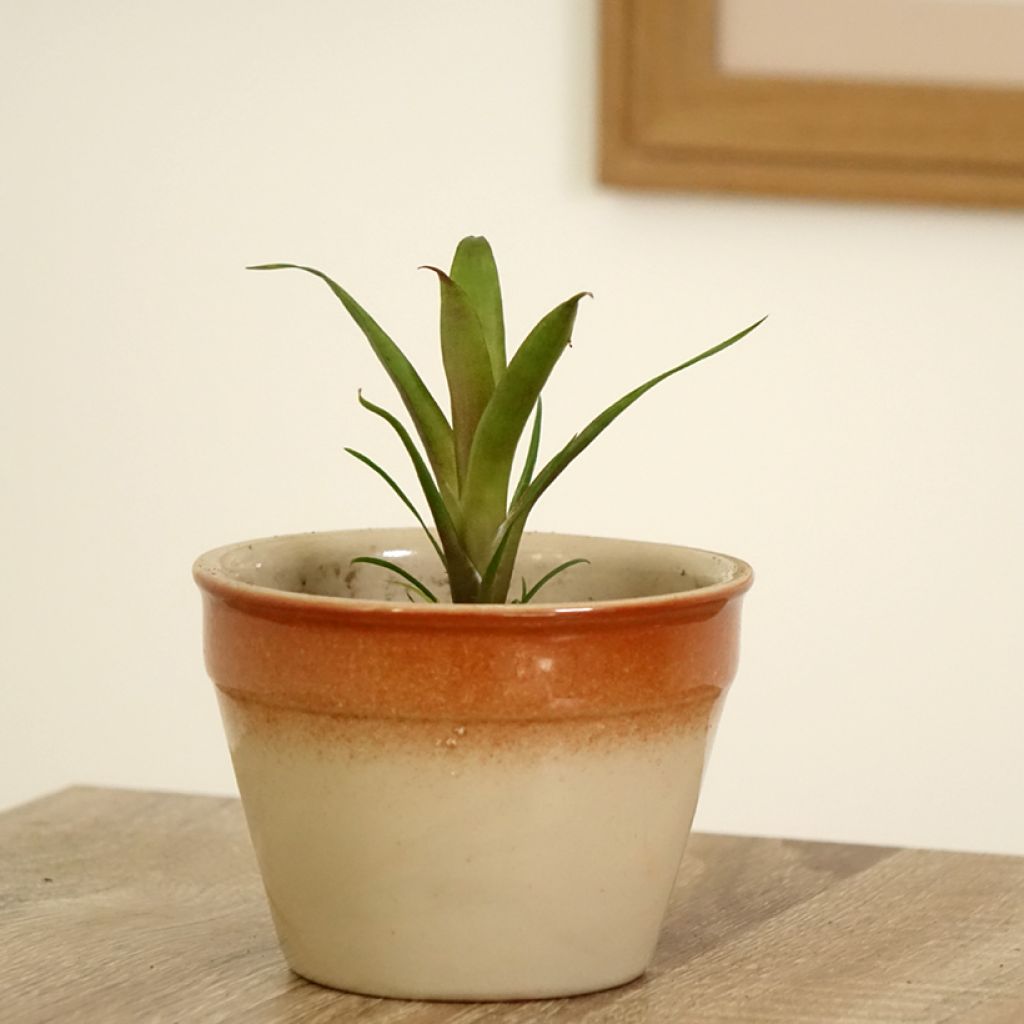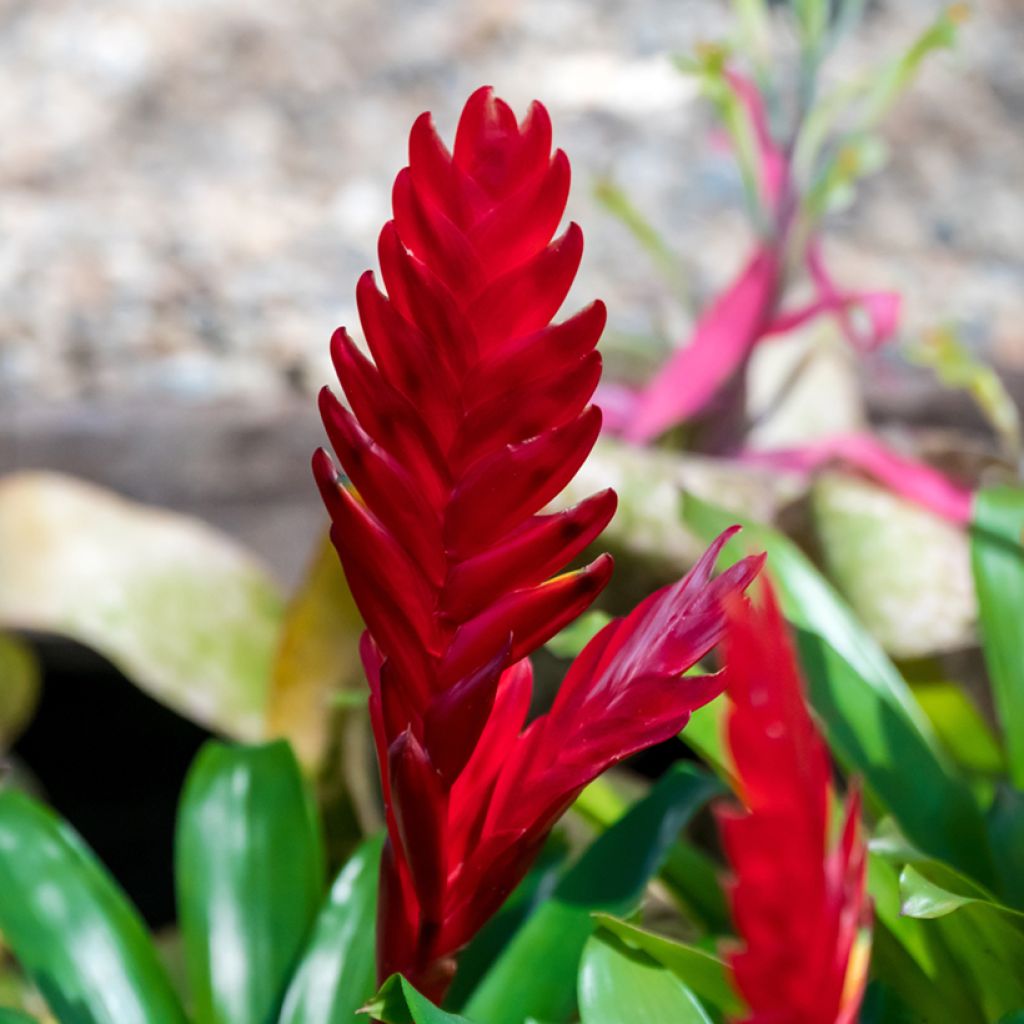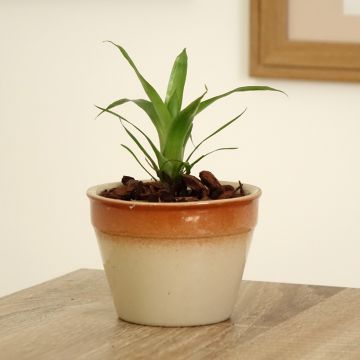

Vriesea carinata Christiane - Flaming sword plant


Vriesea carinata Christiane - Flaming sword plant
Vriesea carinata Christiane - Flaming sword plant
Vriesea carinata Christiane
Flaming sword plant
Home or relay delivery (depending on size and destination)
Schedule delivery date,
and select date in basket
This plant carries a 30 days recovery warranty
More information
We guarantee the quality of our plants for a full growing cycle, and will replace at our expense any plant that fails to recover under normal climatic and planting conditions.
Description
Vriesea 'Christiane' is an elegant houseplant with glossy green foliage in a dense rosette, forming a beautiful setting for its dark red, paddle-shaped inflorescence that remains decorative for weeks. Highly decorative in a well-lit living room but protected from direct sunlight, this beautiful variety will delight all lovers of exotic plants with its robustness and striking appearance.
Vriesea 'Christiane' is a perennial epiphytic plant belonging to the Bromeliaceae family, a cousin of Guzmania and Puyas. This cultivar is derived from the species Vriesea carinata. It is characterised by its rosette of light green leaves, shiny and arched, forming a funnel-shaped structure typical of bromeliads. The smooth and flexible leaves generally measure between 30 and 50 cm in length; they have an elegant texture and give the plant a striking presence indoors. The growth of Vriesea 'Christiane' is slow, with the rosette reaching a height and spread of approximately 30 to 50 cm at maturity. The flowering of Vriesea 'Christiane' is remarkable: a flower spike emerges from the centre of the rosette, bearing a spike-shaped inflorescence composed of overlapping bracts in vibrant red hues. The flowering period can vary but usually occurs after several years of cultivation. The plant is semelparous, meaning it dies after flowering, leaving behind offsets at its base to ensure its propagation. To grow Vriesea 'Christiane' indoors, it is essential to provide it with bright light, avoiding direct sunlight, which could scorch its delicate foliage. An ambient temperature of 18 to 24°C is ideal, with air that is not too dry.
The Vriesea genus includes around 250 species native to the tropical forests of Central and South America, particularly Brazil. These epiphytic plants grow on trees, taking advantage of the canopy to capture filtered light and ambient humidity. Vriesea carinata is more specifically endemic to the Atlantic Forest of southeastern Brazil. The genus name Vriesea pays tribute to the Dutch botanist Willem Hendrik de Vriese (1806-1862), recognised for his contributions to botany and the study of tropical plants.
Create an exotic scene by pairing the Vriesea 'Christiane' with other bromeliads such as Vriesea splendens with its striped foliage and Guzmania 'Luna' with its bright yellow hues. Together, these plants create a stunning tropical palette.
Report an error about the product description
Vriesea carinata Christiane - Flaming sword plant in pictures


Foliage
Plant habit
Flowering
Botanical data
Vriesea
carinata
Christiane
Bromeliaceae
Flaming sword plant
Cultivar or hybrid
Other Vriesea - Flaming sword plant
View all →Location
Location
Maintenance and care
Potting advice, substrates and fertilisers
Houseplant care
Disease and pest advice
Maintenance and care
This item has not been reviewed yet - be the first to leave a review about it.
Haven't found what you were looking for?
Hardiness is the lowest winter temperature a plant can endure without suffering serious damage or even dying. However, hardiness is affected by location (a sheltered area, such as a patio), protection (winter cover) and soil type (hardiness is improved by well-drained soil).

Photo Sharing Terms & Conditions
In order to encourage gardeners to interact and share their experiences, Promesse de fleurs offers various media enabling content to be uploaded onto its Site - in particular via the ‘Photo sharing’ module.
The User agrees to refrain from:
- Posting any content that is illegal, prejudicial, insulting, racist, inciteful to hatred, revisionist, contrary to public decency, that infringes on privacy or on the privacy rights of third parties, in particular the publicity rights of persons and goods, intellectual property rights, or the right to privacy.
- Submitting content on behalf of a third party;
- Impersonate the identity of a third party and/or publish any personal information about a third party;
In general, the User undertakes to refrain from any unethical behaviour.
All Content (in particular text, comments, files, images, photos, videos, creative works, etc.), which may be subject to property or intellectual property rights, image or other private rights, shall remain the property of the User, subject to the limited rights granted by the terms of the licence granted by Promesse de fleurs as stated below. Users are at liberty to publish or not to publish such Content on the Site, notably via the ‘Photo Sharing’ facility, and accept that this Content shall be made public and freely accessible, notably on the Internet.
Users further acknowledge, undertake to have ,and guarantee that they hold all necessary rights and permissions to publish such material on the Site, in particular with regard to the legislation in force pertaining to any privacy, property, intellectual property, image, or contractual rights, or rights of any other nature. By publishing such Content on the Site, Users acknowledge accepting full liability as publishers of the Content within the meaning of the law, and grant Promesse de fleurs, free of charge, an inclusive, worldwide licence for the said Content for the entire duration of its publication, including all reproduction, representation, up/downloading, displaying, performing, transmission, and storage rights.
Users also grant permission for their name to be linked to the Content and accept that this link may not always be made available.
By engaging in posting material, Users consent to their Content becoming automatically accessible on the Internet, in particular on other sites and/or blogs and/or web pages of the Promesse de fleurs site, including in particular social pages and the Promesse de fleurs catalogue.
Users may secure the removal of entrusted content free of charge by issuing a simple request via our contact form.
The flowering period indicated on our website applies to countries and regions located in USDA zone 8 (France, the United Kingdom, Ireland, the Netherlands, etc.)
It will vary according to where you live:
- In zones 9 to 10 (Italy, Spain, Greece, etc.), flowering will occur about 2 to 4 weeks earlier.
- In zones 6 to 7 (Germany, Poland, Slovenia, and lower mountainous regions), flowering will be delayed by 2 to 3 weeks.
- In zone 5 (Central Europe, Scandinavia), blooming will be delayed by 3 to 5 weeks.
In temperate climates, pruning of spring-flowering shrubs (forsythia, spireas, etc.) should be done just after flowering.
Pruning of summer-flowering shrubs (Indian Lilac, Perovskia, etc.) can be done in winter or spring.
In cold regions as well as with frost-sensitive plants, avoid pruning too early when severe frosts may still occur.
The planting period indicated on our website applies to countries and regions located in USDA zone 8 (France, United Kingdom, Ireland, Netherlands).
It will vary according to where you live:
- In Mediterranean zones (Marseille, Madrid, Milan, etc.), autumn and winter are the best planting periods.
- In continental zones (Strasbourg, Munich, Vienna, etc.), delay planting by 2 to 3 weeks in spring and bring it forward by 2 to 4 weeks in autumn.
- In mountainous regions (the Alps, Pyrenees, Carpathians, etc.), it is best to plant in late spring (May-June) or late summer (August-September).
The harvesting period indicated on our website applies to countries and regions in USDA zone 8 (France, England, Ireland, the Netherlands).
In colder areas (Scandinavia, Poland, Austria...) fruit and vegetable harvests are likely to be delayed by 3-4 weeks.
In warmer areas (Italy, Spain, Greece, etc.), harvesting will probably take place earlier, depending on weather conditions.
The sowing periods indicated on our website apply to countries and regions within USDA Zone 8 (France, UK, Ireland, Netherlands).
In colder areas (Scandinavia, Poland, Austria...), delay any outdoor sowing by 3-4 weeks, or sow under glass.
In warmer climes (Italy, Spain, Greece, etc.), bring outdoor sowing forward by a few weeks.


































